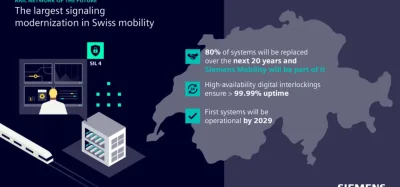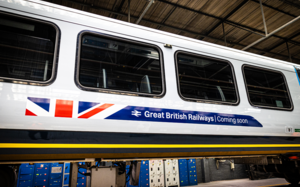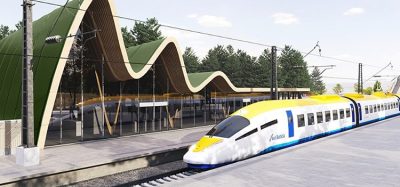The continued development of Switzerland’s rail network
Posted: 30 July 2007 | | No comments yet
Overall mobility in Switzerland is forecast to grow by 15-30% between 2000 and 2030. Public transport is set to grow even faster, increasing its market share at the expense of car travel. For its part, SBB is forecasting an increase of 45% in passenger traffic in the same period. There are several contributory factors including general growth, changes in attitudes to mobility, developments in population and workplace patterns, the competitive effect of road traffic on rail, and not least a growing ecological awareness among broad strata of the population. If we are to cope with this growth, the continued expansion of rail services is essential.
Overall mobility in Switzerland is forecast to grow by 15-30% between 2000 and 2030. Public transport is set to grow even faster, increasing its market share at the expense of car travel. For its part, SBB is forecasting an increase of 45% in passenger traffic in the same period. There are several contributory factors including general growth, changes in attitudes to mobility, developments in population and workplace patterns, the competitive effect of road traffic on rail, and not least a growing ecological awareness among broad strata of the population. If we are to cope with this growth, the continued expansion of rail services is essential.
Overall mobility in Switzerland is forecast to grow by 15-30% between 2000 and 2030. Public transport is set to grow even faster, increasing its market share at the expense of car travel.
For its part, SBB is forecasting an increase of 45% in passenger traffic in the same period. There are several contributory factors including general growth, changes in attitudes to mobility, developments in population and workplace patterns, the competitive effect of road traffic on rail, and not least a growing ecological awareness among broad strata of the population. If we are to cope with this growth, the continued expansion of rail services is essential.
We must also assume that freight traffic will continue to grow in the decades to come, more so on the railways than on the roads. SBB expects the following minimum growth rates (see Table 1).
Join our free webinar: Rail cyber-security in a time of technological and regulatory transformation
Join our expert panel, including speakers from Nokia and Siemens Mobility, to explore the critical convergence of cybersecurity and 5G rail comms.
Date: 3 Dec | Time: 15:00 GMT
Can’t attend live? No worries – register to receive the recording post-event.
If we are to be in a position to handle the expected volume of freight traffic by 2020-2030, we must increase the capacity utilisation of our current train paths. Rail infrastructure managers are therefore seeking suitable incentive systems that will help to smooth out the existing sharp variations in freight-traffic demand over daily, weekly and annual periods. The completion of the Gotthard Base Tunnel line will enable all transit traffic to be hauled by single locomotives. This will improve the capacity utilisation of existing train paths, enabling transalpine freight volume to be doubled with the addition of only about 100 extra train paths per day (+30%). At the same time it will make rail freight traffic more cost-effective. Most of the increase in import/export traffic can be attributed to the growth in unaccompanied intermodal traffic. Efficiency on domestic routes will be improved primarily by means of accelerated train paths and increased standardisation.
A special fund for rail infrastructure expansion
In the last 20 years, SBB has systematically modernised its network. This would not have been possible if it was not for a number of decisions by the Swiss electorate. One of those decisions was its approval in 1998 of ‘FinöV’, the proposal for public-transport infrastructure funding. These funds – which come from a levy on heavy goods vehicles, value-added tax, the oil tax and interim federal loans – are to finance the four major rail projects extending until 2022, which are:
- Up to 2004 Rail 2000, phase 1
- Up to 2012 Link-up to the European high-speed rail network
- Up to 2015 Rail noise abatement
- Up to about 2018: NEAT – the construction of two transit routes through the Alps
Final decisions on Rail 2000 phase 2 have yet to be taken. A bill on the future development of the railway infrastructure – FDRI, or ZEB in German – is expected to come before Parliament in 2008.
The four major projects mentioned above (NEAT, high-speed rail network link, noise abatement and Rail 2000) have been enshrined in an interim provision of the Federal Constitution and enacted in the form of federal legislation. The new bill is expected to replace the four existing laws by a single new FDRI Act, which will set out only the infrastructure expansion required for core aspects of future railway development.
The objectives of FDRI
These are the principal aspects of FDRI:
- Its core features will benefit the whole of Switzerland
- FDRI will complete Rail 2000, extending the hub principle – reducing selected journey times and increasing the frequency of some services. It will thus continue the development of services on the Swiss east-west axis
- FDRI will supplement NEAT with the necessary investment in access routes, thus providing the freight-traffic capacities required to effect the road/rail switch and cope with market growth
- FDRI will jointly develop both long-distance passenger services and freight services
- FDRI will provide no funding for regional traffic, but it will create the latitude for its development and a firm foundation for planning work
FDRI will be guided by commercial principles, both in the configuration of its core services and in selecting options for expansion. In addition to the capital-investment costs, account must also be taken of the resulting operating costs and other follow-on costs. Funds will be spent where market potential and efficiency – for both passenger and freight traffic – are at their greatest.
Core features of FDRI
The core features of FDRI will supplement the hub system of Rail 2000, phase 1. Journey times on the routes between Lausanne-Berne, Biel-Zurich and Zurich-St Gallen will be reduced by 15 minutes. The total saving on the Geneva-St Gallen route will be 30 minutes. Service frequency will be increased on selected track sections in the highest demand.
The new hubs will make it easier for passengers to change trains. The resulting savings in time will reduce overall journey times, thus making public transport more competitive with private car journeys. The greater frequency of selected services will enable us to cope with the increased demand that the future will bring.
Improvements to passenger services
FDRI completes the hub concept of Rail 2000 by expanding existing hubs and implementing the full hubs that were deferred when the project was divided into phases. The resulting improvement to connections, together with higher speeds, mean that FDRI will substantially reduce journey times for passenger services. Every part of the country will benefit, not just those places served directly by main lines:
Journey times between the Lausanne and Berne, Biel and Zurich and Zurich and St Gallen hubs will be reduced by approximately 15 minutes. This will significantly increase the attractions of the east-west axis as the backbone of the Swiss rail network. System time between Lausanne and Visp will be reduced by 15 minutes and capitalise on the good connections at Visp created by the opening of the Lötschberg Base Tunnel. Reduced journey times on other routes will also be seen, including between Berne and Interlaken, Geneva and Lausanne, Biel and Basel, Winterthur and Romanshorn.
Services will be selectively expanded where it is justified by the market to do so. This will include:
- Tilting trains will be deployed on the section between Lausanne and Berne, cutting the journey time to just under an hour
- On the Berne-Zurich section one additional train will run each hour to meet increasing demand
- Faster long-distance trains will run every half-hour between Biel and Zurich, stopping at Solothurn and Olten
- Intercity trains will run every half-hour on the Zurich-Winterthur-St Gallen route. Shortening the journey time between Winterthur and St Gallen will necessitate non-stop services
- There will be a half-hourly service on the Biel-Neuchâtel-Yverdon-Lausanne/Geneva line
- At peak times (weekends and public holidays) extra trains will run on the half-hour between Zurich and Lugano. At other times, capacity will be kept free for freight traffic
FDRI as the basis for planning regional services
The core features of FDRI are urgently required for the continued development of S-Bahn and regional services because they create a solid foundation for the long-term planning of long-distance passenger and freight services that benefits these areas too. Even though the continued development of regional services cannot be funded from the FDRI budget, the expansion of SBB’s infrastructure also creates latitude for the development of regional and S-Bahn services. In addition, the core features of FDRI are compatible with S-Bahn developments that have already been planned.
Improvements in freight services
The railways carry 40% of Swiss freight traffic. On our heavily-utilised rail network, FDRI also meets the expansion requirements for freight services, enabling us to maintain this high ratio – it makes us the European leader – and to cope with forecast growth and the switch from road to rail in transalpine freight services. The core features of FDRI take account of the following developments:
- Meeting the target for transferring transalpine traffic from road to rail
- Forecast market growth in north-south and import/export traffic, particularly in intermodal segment
- Moderate growth in domestic traffic on heavily used routes
- Acceleration and systematisation of east-west freight traffic at the foot of the Jura escarpment.
The upgrading of access routes envisaged in FDRI will permit the capacity of the base tunnels to be fully utilised, while enabling the transfer of transalpine freight traffic from road to rail to be achieved as planned – provided that supporting measures have been taken to simplify track layouts at either end. Furthermore, FDRI secures capacities for the market growth in transalpine freight traffic that is expected to occur by 2030. This presupposes that the switch will primarily involve efficient unaccompanied intermodal traffic.
In the fast-growing import/export field, FDRI secures the required capacities on the route between Basel and the Limmattal marshalling yard, where freight wagons are fed into the heavily-used wagonload network and conveyed directly to customers’ sidings. For the fast-growing field of container traffic, the Limmattal marshalling yard will by 2012 have a modern container terminal – not funded under FDRI – from where containers will either continue their journey by rail or be transferred to road for delivery to individual customers in the Greater Zurich area.
In domestic freight services, FDRI will primarily bring about improvements in quality. It will secure current capacities for freight – and, where necessary, selectively add to them. On the east-west axis FDRI will enable a ‘freight clockface timetable’ to be implemented, with perceptible cuts in transit times. The acceleration will be particularly significant for the express freight trains operated for Swiss Post and the major Swiss retail chains.
Tilting trains – plus investment in the nationwide rail network
The sum currently earmarked for FDRI investment is approximately CHF 5 billion. This includes the expansion of NEAT access routes, stabling facilities, energy supply and noise-abatement measures. It does not include any reserves, however.
The new rail hubs – Lausanne, Biel and St Gallen – necessitate reductions in journey times on the east-west axis between Lausanne and Berne, Biel and Zurich, Zurich and St Gallen, Lausanne and Visp. One factor making this possible will be the deployment of tilting trains, which reduce the need for investment in infrastructure.
Speed and frequency will both be increased in the Olten-Killwangen corridor, making this a focal point for investment that will benefit the whole of Switzerland. The most important themes are untangling the traffic flows in Olten and Liestal, the Eppenberg tunnel bypassing Schönenwerd and the newly Chestenberg line bypassing Lenzburg.
The route between Lausanne and Berne will be upgraded for tilting trains in connection with the implementation of the full hub at Lausanne and the reduction of journey times. Also, an additional track will be added to the Lausanne-Renens section.
The core features of FDRI are crucially dependent on the new Zurich cross-city line for speeding up east-west services. In order to handle the growth in traffic between Zurich and Winterthur, capacity in this corridor will be expanded by further reducing headways between trains and adding extra tracks and two flyovers along the existing route. Capacity between Zurich and central Switzerland will be increased by a number of measures, one of them the expansion of the Thalwil bottleneck.
In order to maximize capacity utilisation of the new Gotthard and Ceneri base tunnels, headways between freight trains will be generally standardised at three minutes. FDRI investment in Switzerland’s rail infrastructure is closely coordinated with the measures – already approved and funded – relating to the ‘performance agreement’ between the Swiss government and the railways, links to the European high-speed rail network and the infrastructure fund, all of which may be regarded as a single over-arching scheme.
Expansion options: the next steps
The expansion options selectively supplement the core FDRI features on a regional basis. They take account of the wishes of the cantons, which were involved in the planning process. It only makes sense to implement them in addition to the core features. The improved services described above will be achieved by executing the following infrastructure measures:
- Higher frequency on Lausanne-Geneva route.
Service: half-hourly Intercity and Regio express trains, 1/4-hourly Interregio trains. Infrastructure requirement: installation of a third track between Allaman and Renens, reconstruction of several stations along this line.
Costs: approximately CHF 410 million. - Higher frequency at the foot of the Jura escarpment.
Service: half-hourly between Biel and Lausanne, hourly between Biel and Geneva. Infrastructure requirement: installation of a third track between Biel and Lengnau, installation of a double-track line between Ligerz and Twann, station reconstruction at Yverdon, installation of a third track between Denges and Morges.
Costs: approximately CHF 620 million (CHF 400 million if carried out simultaneously with increasing frequency between Lausanne and Geneva). - Higher frequency on Berne-Brig route.
Service: integral half-hourly.
Infrastructure requirement: installation of equipment in the section Ferden-Mitholz (already cut) of the Lötschberg Base Tunnel.
Costs: approximately CHF 460 million. - Higher speeds on Lucerne-Zurich route without the extension of the Zimmerberg Tunnel to Cham.
Service: journey time reduced by 3-5 minutes.
Infrastructure requirement: extension of the Rotsee line to a double-track line plus incidental measures.
Costs: approximately CHF 190 million. - Higher speeds on Lucerne-Zurich line with the extension of the Zimmerberg Tunnel to Cham.
Service: journey time reduced by 7-12 minutes.
Infrastructure requirement: Zimmerberg Tunnel phase 2, double-track Rotsee line, double-track island in the Zug-Oberwil area plus other incidental measures.
Costs: approximately CHF 1100 million.
Conclusion
The core features of FDRI and Rail 2000 phase 2 enable Switzerland to continue developing its public transport network in a rational fashion. FDRI spells a continuation of the transport policy pursued by Switzerland over the last 20 years, namely to expand its rail network in parallel with the national road-building programme. Continuous, phased expansion has proved its worth, as is clear from the sharp increases in both passenger numbers and freight volumes. This policy must be maintained, as the following factors make clear:
- Rail 2000 phase 1 has brought Switzerland’s rail network to the limits of its capacity. The expansion of services envisaged as the core feature of the FDRI will continue the 20-year strategy of developing the network and the services it delivers.
- The core features of FDRI will implement a significant proportion of the passenger-transport development that is required by Switzerland as a whole in the decade to come, creating freight traffic capacity to cope with market growth and meet the objective of transferring freight from road to rail.
- The core features of FDRI are commercially attractive, burdening the federal government with only minimal follow-on costs.
- The core features of FDRI form the urgently-required basis for planning the continued development of the S-Bahn networks and regional services.
- The core features of FDRI are part of an overall package that is inextricably linked with other extensions to the rail network.
Outlook
Parliament is expected to debate the FDRI bill next year. The programme prepared by SBB for its future infrastructure and services, costing a total of some five billion francs, is the maximum option put forward by SBB and yet does not meet all the wishes of either the railway itself nor of the cantons. SBB has made every effort to prepare a programme within the budget available to it that will bring improvements throughout the country, with a tailor-made infrastructure to ensure maximum benefits. We must be far-sighted today in the interests of tomorrow.
About the author
Mr. Hansjörg Hess has been Head of Infrastructure at the Swiss Federal Railways SBB since 2004. He has held leading positions at Siemens in Switzerland and abroad in the fields of electrical engineering, communications technology and railway signalling technology. Before working for SBB, Mr. Hess was Chairman of Siemens Rail Automation in Braunschweig/Germany.
Stay Connected with Global Railway Review — Subscribe for Free!
Get exclusive access to the latest rail industry insights from Global Railway Review — all tailored to your interests.
✅ Expert-Led Webinars – Gain insights from global industry leaders
✅ Weekly News & Reports – Rail project updates, thought leadership, and exclusive interviews
✅ Partner Innovations – Discover cutting-edge rail technologies
✅ Print/Digital Magazine – Enjoy two in-depth issues per year, packed with expert content
Choose the updates that matter most to you. Sign up now to stay informed, inspired, and connected — all for free!
Thank you for being part of our community. Let’s keep shaping the future of rail together!
Issue
Related topics
Cargo, Freight & Heavy-Haul, Funding & Finance, Infrastructure Developments








